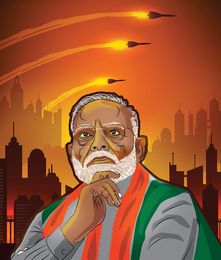Narendra Modi is the first Indian prime minister ever to not be on record on nuclear disarmament. His attention has been devoted to building our nuclear capabilities and delivery systems without mentioning universal disarmament. The authoritative International Panel on Fissile Materials has estimated, mainly on the basis of Indian government data, that we now have approximately 680kg (plus/minus 160kg) of weapons-grade plutonium in addition to highly enriched uranium to make 130-210 nuclear warheads, although our capacity to launch them is limited to an estimated 172. We are, however, rapidly developing missile delivery systems. Agni-V is in the final stages of operationalisation. Its unique feature is that it can be stored in canisters to enable pre-mating of missiles and warheads, besides perhaps taking our range to 6,000km (from Prithvi-II’s 350km). Next in line is the medium-range Agni-P, which replaces the first three Agni missiles. It can be equipped with Multiple Independently Targetable Re-entry Vehicles or variations thereof to match Pakistan’s medium-range Ababeel, which is armed with MIRVs. Long-range Agni-VI, an inter-continental ballistic missile, follows. This arguably presages the “decoupling” of our nuclear strategy for deterring China, which involves long-range missiles, from deterring Pakistan with highly sophisticated short-range ballistic missiles. We are well and truly into a nuclear arms race, precisely of the kind we used to deplore when the US and the Soviet Union were playing catch-up.
Meanwhile, the second side of the triad—air—has been bolstered with Rafale, the upgrading of Mirage 2000-H to Mirage 2000-5, the upgrading also of Jaguar with DARIN-III precision attack and avionics (despite the decision to retire the Jaguar soon). We must also note the proposed establishment of maintenance, repair, overhaul facilities near Jewar airport in Noida. We are also strengthening the third side of the triad—naval—by the commissioning of a second nuclear submarine, INS Arighaat, on August 29, 2024, and a large naval base at Rambilli.
These are all pointers to the Modi establishment surreptitiously drifting away from the two pillars of the nuclear weapons policy formulated by the Vajpayee government in the aftermath of Pokhran-II: ‘Minimum Nuclear Deterrence’ and ‘No First Use’. We are now switching to the same nuclear deterrence theories of Mutually Assured Destruction and a never-ending nuclear arms race that we used to warn against from Mahatma Gandhi onwards. To cite Rajiv Gandhi: “There can be no iron-clad guarantee against the use of weapons of mass destruction… the insane logic of mutually assured destruction will ensure that nothing survives”.
With the highest density of population in the world in Indian cities, our vulnerability to nuclear attack is arguably the highest in the world. We would become an uninhabitable wasteland. ‘Bombing Bombay’, a 1999 paper by M.V. Ramana of the Massachusetts Institute of Technology, estimated, on 1991 census figures, that “a 15-kiloton explosion” in Bombay would result in “1,60,000 to 8,66,000 (instantaneous) deaths”, followed by “hundreds of thousands” of “injuries or burns” leading to the painful death of most, besides “genetic mutations” that would last for generations. Population density in Bombay stood at 16,461 per sqkm in 1991. North-east Delhi in 2001 had a density of 29,397 persons. The higher the density, the higher the instantaneous loss of life.
That is why we consistently advocated universal nuclear disarmament even as we became a nuclear weapon state. It is Modi’s failure to continue that advocacy of disarmament that is the single biggest threat to the continuation of our existence.
(Views expressed are personal.)
Aiyar is a former Union minister and social commentator.


